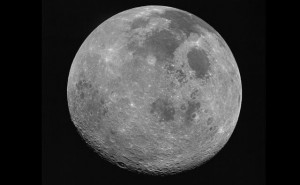 I am a big fan of BBC Radio Four’s In Our Time. The format is always the same: veteran broadcaster Melvyn Bragg plus three top British academics discuss a particular topic.
I am a big fan of BBC Radio Four’s In Our Time. The format is always the same: veteran broadcaster Melvyn Bragg plus three top British academics discuss a particular topic.
It is not in the least bit dumbed down, being 45 minutes of intense talk about things like ‘The Safavid Dynasty’. I can recommend it heartily. It’s entire 10 year archive is available on-line and is available outside of the UK too.
A recent IOT covered the moon. As a programme is was only so-so, starting badly with someone lazily describing basalt as a mineral – a real shout-at-the-radio moment. It contained some absolutely fantastic stuff though.
Why there is lots of anorthosite on the moon – The formation of the moon was discussed. I was hazily aware of the giant impact hypothesis, but hadn’t really thought through how amazing it was. Simply put, very early in the history of the solar system two bodies both smaller than the earth collide. When the ‘dust settles’ the material ends up with a large body (the earth) and a smaller one in orbit (the moon). This explains lots of odd things, such as why the moon and earth have similar isotopic compositions. What I hadn’t realised is how extraordinary the moon’s composition is. Moon rocks contain virtually no volatile elements, ones with low boiling points. This isn’t just water, this means Sodium and Potassium were ‘boiled off’ from rock involved in the impact. The heat caused by the impact caused these elements to vaporise and be lost to the moon. As the magma on the moon later cooled and crystallised plagioclase, it is anorthite, the Calcium-rich version. This explains why the moon is unusually rich in anorthosite.
Record of the early earth – The best bits of the programme came from Ian Crawford talking about the lunar soil. The surface of the moon is covered with a soil-like layer called the regolith. In the early stages of the Apollo missions there was a worry that lunar landers would sink into it. The regolith acts as a sponge, grabbing hold of whatever is flying around. The fabulous bit comes from his speculation about what might be held in there.
There is a big gap in the earth’s history. We can infer from the age of the moon (four and a half billion years old, or 4.53 Ga in geology speak) that the earth was formed at this time. For the next 500 million years we have very little evidence of what was going on, just a few mineral grains preserved in younger rocks. We believe this was a period of intense meteorite bombardment, which might help explain the fact rocks of this age are not preserved. Ian Crawford believes that precious samples of these rocks are preserved in the lunar regolith. In the same way we have lunar meteorites here on earth, material thrown up from the earth would have landed on the moon. Areas of regolith of this age are believed to exist, preserved pristine underneath lava flows.
There’s more. The sponge like regolith might contain ancient gas, escaped from the earth’s atmosphere way back in Earth history. A record of gamma-ray bursts, ancient supernovae, or clumps of interstellar dust, or the solar wind might also be preserved. In the right area, with some form of stratigraphy of datable lava flows and regolith it would be possible to measure the pattern of these things over time.
I love the idea that the moon is a form of archive of the earth’s early history, containing evidence erased from the earth and found nowhere else. It makes the moon and earth seem more equal perhaps. Like twins with a shared traumatic early history that one has forgotten and the other remembers for them both.
A bit of me is a little sceptical as well, but Ian Crawford needs to persuade someone to fund his research so you can’t blame him for talking up all the possible angles. His is no ordinary funding problem of course, since it requires detailed field work and sampling on the moon, perhaps requiring a moon-base. Since no sane politician would propose spending money on such a thing at the moment, we may all have to wait a while to know what ancient secrets the lunar regolith is preserving.

Yes, itsa great series & MrBragg is great at getting clear explanations from the experts. The best one is the Geological formation of the Britain (in our time archive: science Oct 09).
Love the blog!
Pingback: Accretionary Wedge #49: Out of This World | En Tequila Es Verdad